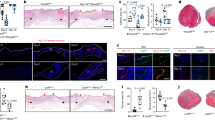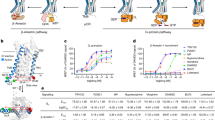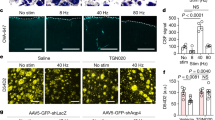Abstract
Previous anti-inflammatory strategies against sepsis, a leading cause of death in hospitals, had limited efficacy in clinical trials, in part because they targeted single cytokines and the experimental models failed to mimic clinical settings1,2,3. Neuronal networks represent physiological mechanisms, selected by evolution to control inflammation, that can be exploited for the treatment of inflammatory and infectious disorders3. Here, we report that sciatic nerve activation with electroacupuncture controls systemic inflammation and rescues mice from polymicrobial peritonitis. Electroacupuncture at the sciatic nerve controls systemic inflammation by inducing vagal activation of aromatic L-amino acid decarboxylase, leading to the production of dopamine in the adrenal medulla. Experimental models with adrenolectomized mice mimic clinical adrenal insufficiency4, increase the susceptibility to sepsis and prevent the anti-inflammatory effects of electroacupuncture. Dopamine inhibits cytokine production via dopamine type 1 (D1) receptors. D1 receptor agonists suppress systemic inflammation and rescue mice with adrenal insufficiency from polymicrobial peritonitis. Our results suggest a new anti-inflammatory mechanism mediated by the sciatic and vagus nerves that modulates the production of catecholamines in the adrenal glands. From a pharmacological perspective, the effects of selective dopamine agonists mimic the anti-inflammatory effects of electroacupuncture and can provide therapeutic advantages to control inflammation in infectious and inflammatory disorders.
This is a preview of subscription content, access via your institution
Access options
Subscribe to this journal
Receive 12 print issues and online access
$209.00 per year
only $17.42 per issue
Buy this article
- Purchase on Springer Link
- Instant access to full article PDF
Prices may be subject to local taxes which are calculated during checkout




Similar content being viewed by others
References
Angus, D.C. & van der Poll, T. Severe sepsis and septic shock. N. Engl. J. Med. 369, 840–851 (2013).
Ulloa, L. & Tracey, K.J. The “cytokine profile”: a code for sepsis. Trends Mol. Med. 11, 56–63 (2005).
Ulloa, L. The vagus nerve and the nicotinic anti-inflammatory pathway. Nat. Rev. Drug Discov. 4, 673–684 (2005).
Annane, D. Adrenal insufficiency in sepsis. Curr. Pharm. Des. 14, 1882–1886 (2008).
Tracey, K.J. et al. Anti-cachectin/TNF monoclonal antibodies prevent septic shock during lethal bacteraemia. Nature 330, 662–664 (1987).
Riedemann, N.C., Guo, R.F. & Ward, P.A. Novel strategies for the treatment of sepsis. Nat. Med. 9, 517–524 (2003).
Ulloa, L., Brunner, M., Ramos, L. & Deitch, E.A. Scientific and clinical challenges in sepsis. Curr. Pharm. Des. 15, 1918–1935 (2009).
Nathan, C. Points of control in inflammation. Nature 420, 846–852 (2002).
Abraham, E. et al. Lenercept (p55 tumor necrosis factor receptor fusion protein) in severe sepsis and early septic shock: a randomized, double-blind, placebo-controlled, multicenter phase III trial with 1,342 patients. Crit. Care Med. 29, 503–510 (2001).
Borovikova, L.V. et al. Vagus nerve stimulation attenuates the systemic inflammatory response to LPS. Nature 405, 458–462 (2000).
Huston, J.M. et al. Splenectomy inactivates the cholinergic antiinflammatory pathway during lethal endotoxemia and polymicrobial sepsis. J. Exp. Med. 203, 1623–1628 (2006).
Peña, G. et al. Cholinergic regulatory lymphocytes re-establish neuromodulation of innate immune responses in sepsis. J. Immunol. 187, 718–725 (2011).
Bernik, T.R. et al. Cholinergic antiinflammatory pathway inhibition of tumor necrosis factor during ischemia reperfusion. J. Vasc. Surg. 36, 1231–1236 (2002).
Altavilla, D. et al. Activation of the cholinergic anti-inflammatory pathway reduces NF-kappab activation, blunts TNF-α production, and protects againts splanchic artery occlusion shock. Shock 25, 500–506 (2006).
Cai, B. et al. α7 cholinergic-agonist prevents systemic inflammation and improves survival during resuscitation. J. Cell. Mol. Med. 13, 3774–3785 (2009).
van Westerloo, D.J. et al. The vagus nerve and nicotinic receptors modulate experimental pancreatitis severity in mice. Gastroenterology 130, 1822–1830 (2006).
Pullan, R.D. et al. Transdermal nicotine for active ulcerative colitis. N. Engl. J. Med. 330, 811–815 (1994).
Wang, H. et al. Cholinergic agonists inhibit HMGB1 release and improve survival in experimental sepsis. Nat. Med. 10, 1216–1221 (2004).
van Westerloo, D.J. et al. The cholinergic anti-inflammatory pathway regulates the host response during septic peritonitis. J. Infect. Dis. 191, 2138–2148 (2005).
Vickers, A.J. et al. Acupuncture for chronic pain: individual patient data meta-analysis. Arch. Intern. Med. 172, 1444–1453 (2012).
Lee, A. & Done, M.L. Stimulation of the wrist acupuncture point P6 for preventing postoperative nausea and vomiting. Cochrane Database Syst. Rev. CD003281 (2004).
Napadow, V. & Kaptchuk, T.J. Patient characteristics for outpatient acupuncture in Beijing, China. J. Altern. Complement. Med. 10, 565–572 (2004).
Wu, H.M. et al. Acupuncture for stroke rehabilitation. Cochrane Database Syst. Rev. CD004131 (2006).
Goldman, N. et al. Adenosine A1 receptors mediate local anti-nociceptive effects of acupuncture. Nat. Neurosci. 13, 883–888 (2010).
Ernst, E., Lee, M.S. & Choi, T.Y. Acupuncture: does it alleviate pain and are there serious risks? A review of reviews. Pain 152, 755–764 (2011).
Vida, G. et al. β2-Adrenoreceptors of regulatory lymphocytes are essential for vagal neuromodulation of the innate immune system. FASEB J. 25, 4476–4485 (2011).
Coupland, R.E., Parker, T.L., Kesse, W.K. & Mohamed, A.A. The innervation of the adrenal gland. III. Vagal innervation. J. Anat. 163, 173–181 (1989).
Wang, H. et al. Nicotinic acetylcholine receptor α7 subunit is an essential regulator of inflammation. Nature 421, 384–388 (2003).
Vida, G., Peña, G., Deitch, E.A. & Ulloa, L. α7-nicotinic receptor mediates vagal induction of splenic norepinephrine. J. Immunol. 186, 4340–4346 (2011).
Grenader, A. & Healy, D.P. Fenoldopam is a partial agonist at dopamine-1 (DA1) receptors in LLC-PK1 cells. J. Pharmacol. Exp. Ther. 258, 193–198 (1991).
Weber, R.R. et al. Pharmacokinetic and pharmacodynamic properties of intravenous fenoldopam, a dopamine1-receptor agonist, in hypertensive patients. Br. J. Clin. Pharmacol. 25, 17–21 (1988).
Denef, C., Manet, D. & Dewals, R. Dopaminergic stimulation of prolactin release. Nature 285, 243–246 (1980).
Gorissen, H. & Laduron, P. Solubilisation of high-affinity dopamine receptors. Nature 279, 72–74 (1979).
Morelli, A. et al. Prophylactic fenoldopam for renal protection in sepsis: a randomized, double-blind, placebo-controlled pilot trial. Crit. Care Med. 33, 2451–2456 (2005).
Sorkin, L.S. & Yaksh, T.L. Behavioral models of pain states evoked by physical injury to the peripheral nerve. Neurotherapeutics 6, 609–619 (2009).
Richner, M., Bjerrum, O.J., Nykjaer, A. & Vaegter, C.B. The spared nerve injury (SNI) model of induced mechanical allodynia in mice. J. Vis. Exp. 3092 (2011).
Kadl, A., Pontiller, J., Exner, M. & Leitinger, N. Single bolus injection of bilirubin improves the clinical outcome in a mouse model of endotoxemia. Shock 28, 582–588 (2007).
Panayotis, N. et al. Morphological and functional alterations in the substantia nigra pars compacta of the Mecp2-null mouse. Neurobiol. Dis. 41, 385–397 (2011).
Ulloa, L., Doody, J. & Massague, J. Inhibition of transforming growth factor-beta/SMAD signalling by the interferon-gamma/STAT pathway. Nature 397, 710–713 (1999).
Acknowledgements
We thank P. Morcillo, J.M. Inclan-Rico and J.R. Berlin for their comments and suggestions and M. Marks (University of Colorado) and B. Kobilka (Stanford University) for the α7nAChR and β2AR knockout mice. R.T.-R. was supported by the University Autónoma Benito Juarez de Oaxaca. M.d.R.T.-B. was supported by the Mexican National Council for Science and Technology. L.U. is supported by the faculty program of the Department of Surgery of the New Jersey Medical School, the Foundation of University of Medicine and Dentistry of New Jersey and US National Institutes of Health grant RO1-GM084125.
Author information
Authors and Affiliations
Contributions
R.T.-R., G.Y., G.P., P.M. and M.d.R.T.-B. performed the experiments, prepared the figures and revised the article. M.A.M.-E., L.A.A.-P. and A.I. contributed to the design of the study and revised the paper. L.U. designed and directed the study and wrote the paper.
Corresponding author
Ethics declarations
Competing interests
The authors declare no competing financial interests.
Supplementary information
Supplementary Text and Figures
Supplementary Figures 1–3 (PDF 199 kb)
Rights and permissions
About this article
Cite this article
Torres-Rosas, R., Yehia, G., Peña, G. et al. Dopamine mediates vagal modulation of the immune system by electroacupuncture. Nat Med 20, 291–295 (2014). https://doi.org/10.1038/nm.3479
Received:
Accepted:
Published:
Issue Date:
DOI: https://doi.org/10.1038/nm.3479
This article is cited by
-
Voltammetry in the spleen assesses real-time immunomodulatory norepinephrine release elicited by autonomic neurostimulation
Journal of Neuroinflammation (2023)
-
Feasibility of electroacupuncture at Baihui (GV20) and Zusanli (ST36) on survival with a favorable neurological outcome in patients with postcardiac arrest syndrome after in-hospital cardiac arrest: study protocol for a pilot randomized controlled trial
Pilot and Feasibility Studies (2023)
-
α7 Nicotinic acetylcholine receptor: a key receptor in the cholinergic anti-inflammatory pathway exerting an antidepressant effect
Journal of Neuroinflammation (2023)
-
Electroacupuncture-driven endogenous circulating serum exosomes as a potential therapeutic strategy for sepsis
Chinese Medicine (2023)
-
Electroacupuncture improves swallowing function in a post-stroke dysphagia mouse model by activating the motor cortex inputs to the nucleus tractus solitarii through the parabrachial nuclei
Nature Communications (2023)



